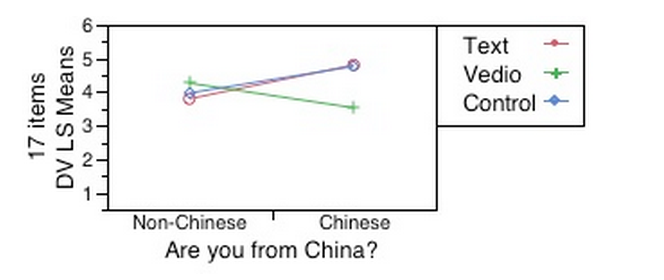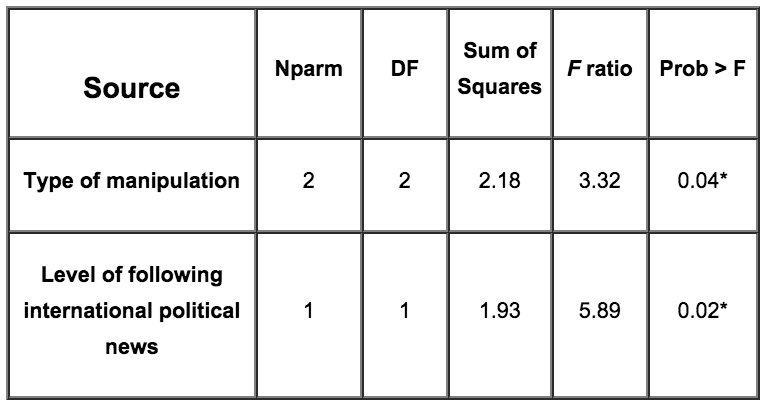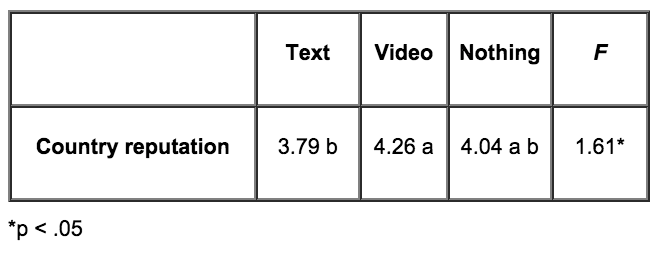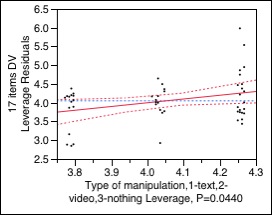Media Effects Research Lab - Research Archive
Media modality effects on perceptions of china: A study of text and video frames
Student Researcher(s)
Steve Bien-Aime (Ph.D Candidate);
Ruobing Li (Ph.D Candidate);
Lian Ma (Ph.D Candidate);
Faculty Supervisor
INTRODUCTION
In order to examine media modality effects on the public’s perceptions of foreign countries, an online experimental study was conducted among college students. Participants were randomly assigned into three groups, with one group being exposed to a text-only news story of China, one group being exposed to a video story of China, and the third group being given no news exposure to serve as a baseline. The study also examined different modality effects on Chinese and non-Chinese people. Implications and limitations of the study were discussed.
RESEARCH QUESTION(S) AND HYPOTHESES:
RQ1: For people, controlling for their levels of following international political news, what is the relationship between media modalities, nationality and perceptions of China?
RQ2: For non-Chinese people, controlling for their levels of following international political news, what is the relationship between media modalities and perceptions of China?
Three hypotheses to RQ2:
H1: A negatively framed text-only article will negatively impact China’s reputation.
H2: A negatively framed video will negatively impact China’s reputation.
H3: Negative text framing will have a different effect on China’s reputation from negative video framing.
METHOD
An online experiment was conducted among participants (N=67) recruited from college students. An original AP story about the imprisonment of the Nobel Peace Prize winner Liu Xiaobo was used as the video stimulus material. The text stimulus material was created by taking verbatim from the video. Media modality was the independent variable (nominal) and country image was the dependent variable (interval). The measurement for country image was a 17-item scale, using a 7-point Likert scale with 1 being strongly disagree and 7 being strongly agree. One control variable was the level of following international political news (interval), using a 7-point Likert scale. There was one moderating variable (nominal), i.e. nationality (Chinese or non-Chinese). The procedure: a pretest was conducted (Cronbach’s α = 0.92) before the actual online experiment. Participants received a survey monkey link from their emails. After clicking the link, they first saw a consent form, questions about demographics, and then a manipulation check question. They were then randomly assigned into one of the three condition groups (text, video, or nothing). After receiving treatments, they filled out an online questionnaire about their perceptions of China. At the end, they filled out questions asking whether they were Americans, whether they were from China, and the average amount of time spent on news consumption in a week. Finally, a 3×2 factorial ANOVA analysis and a one-way ANOVA analysis were used to analyze the data.
RESULTS
RQ1: A significant interaction effect of different media modalities on China’s reputation was found between Chinese people and non-Chinese people, F (2, 67) = 5.30, p < .01. (See Table 1 and Figure 1). For the Chinese, video had a more negative effect on their perceptions of China (M= 3.53) compared with those who were exposed to the test (M= 4.81) and the control group (M= 4.78). For the non-Chinese, video (M= 4.27) had a rather positive effect on their perceptions of China than the control group (M= 3.97) and those who were exposed to the text (M= 3.80).
Table 1 Interaction Effect of Type of Media Modalities and Nationality on Country Reputation

Figure 1 Interaction Effect of Type of Media Modalities and Nationality on Country Reputation)

RQ2: For the non-Chinese, a significant main effect of the effect of type of media modalities on perceptions of China was found, F (2, 56) = 3.320, p < .05. For non-Chinese, different types of media modalities had different effects on people’s perceptions of China. (See Table 2)
Table 2: Main Effect of Type of Media Modalities on China’s Reputation

H1: not supported as the text group (M= 3.79) was not significantly different from the control group (M= 4.04). (See Table 3 and Figure 2)
H2: not supported as the video group (M= 4.26) was not significantly different from the control group (M= 4.04). (See Table 3 and Figure 2)
H3: supported as the text group (M= 3.79) was significantly different from the video group (M= 4.26). (See Table 3 and Figure 2)
Table 3: Means and F-value of Country Reputation as a Function of Media Modalities

Figure 2: Main effect of Type of Media Modalities on Country reputation.

CONCLUSIONS
The findings show that different media modalities have a different framing effect on people’s perception of China. For the Chinese, reading a negative news story of China is not going to change their preexistent beliefs about China given they were well informed about China. For the non-Chinese, as they may have already had a negative frame of China from the media, i.e. “Communist China”, they were not impacted by the text news about China. However, when they watched scenes of Chinese people protesting on the street, they might have been impressed that the Chinese people actually have some kind of political freedom. Therefore, they rather rated their perceptions of China as being more positive.
The finding that different media modality has different effect on perception was consistent with previous studies about modality and information perception. The current study extends modality effects on perception to public’s perception of foreign countries. However, the study was limited in terms of sample size, experimental setting, and the nature of the stimulus material being not negative enough.
For more details regarding the study contact
Dr. S. Shyam Sundar by e-mail at sss12@psu.edu or by telephone at (814) 865-2173

